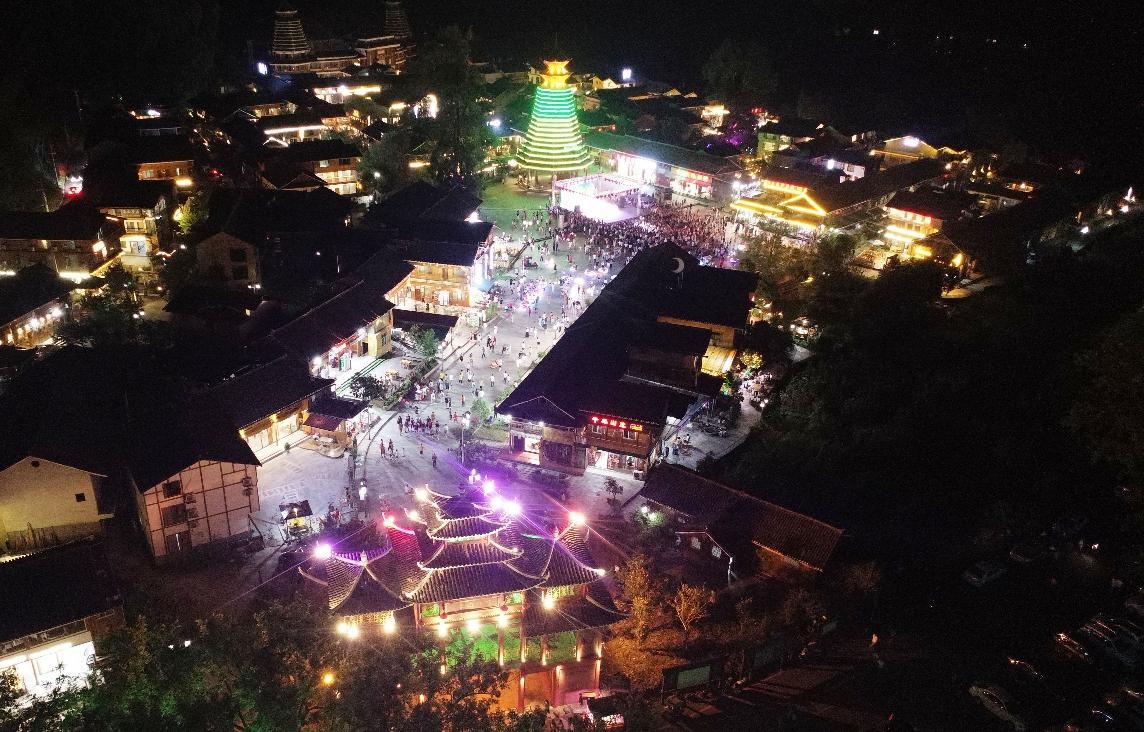Villages around Mount Fanjing in SW China find green paths to prosperity
By taking advantage of local ecological resources, villages around Fanjingshan (Mount Fanjing) National Nature Reserve in southwest China’s Guizhou province have found their roads to prosperity.

Photo shows Fanjingshan (Mount Fanjing) National Nature Reserve in southwest China’s Guizhou province. (People’s Daily Online/ Wang Hua)
At the monitoring center of the management bureau of the nature reserve, several white light spots, which seemed to be moving, suddenly appeared on the fire alarm system of a large screen supported by infrared thermal imaging technology.
“It doesn’t signify a fire,” said Lei Xiaoping, deputy head of the management bureau, who realized immediately that a group of gray snub-nosed monkeys entered the monitoring range of the system.
Mount Fanjing, situated in Tongren city of Guizhou, has preserved a mid-subtropical island mountain ecosystem and is rich in biodiversity.
In 2018, Mount Fanjing was added to the United Nations Educational, Scientific and Cultural Organization’s (UNESCO) World Heritage List, and the Fanjingshan scenic spot was granted a 5A rating, the topmost level of the country’s tourist attraction rating system.
Mount Fanjing is a gene pool of flora and fauna. It is home to over 7,000 wild animal and plant species.

Zhaishadong village at the foot of Mount Fanjing in southwest China’s Guizhou province is ablaze with lights and crowded with tourists, July 10, 2021. (People’s Daily Online/Li He)
To maintain the authenticity and integrity of the natural ecosystems of Mount Fanjing, the municipal government of Tongren issued regulations on the protection and management of the mountain in 2018.
To put under comprehensive protection the animals and plants at the Fanjingshan National Nature Reserve, which covers a large area, the management bureau of the nature reserve has set up a team of over 100 rangers and installed infrared cameras and surveillance devices to realize integrated management for work including ecological investigations, fire prevention and protection, fight against unlawfully felling trees and poaching as well as the approval of construction activities, according to Lei.
Zhaishadong village at the foot of Mount Fanjing was once a typical poverty-stricken mountainous village. In 2010, the per capita net income of residents in the village was less than 2,000 yuan ($313.4).
To alleviate poverty, the local government decided to explore eco-tourism to stimulate economic development while protecting ecological resources.
While relocating all residents in the core areas of the nature reserve, the local government began to develop rural tourism moderately at some experimental zones of the nature reserve, creating more income sources for villagers nearby.
Since 2011, taking advantage of the unique geographical gifts and cultural tourism resources of Zhaishadong village, the local government has gradually changed the village into a pristine eco-tourism destination that combines folk culture, B&B, catering services, and live performances.
After being added to the UNESCO World Heritage List, Mount Fanjing has won increasing fame and attracted more tourists from across the country.
“Many tourists come to Zhaishadong village after their tour of Mount Fanjing. They live in B&Bs, enjoy local food, and take part in bonfire parties of the Dong ethnic group,” said Xia Yongfa, a resident of the village who has transformed his old house for agritainment business.
“During holidays, tourists usually need to make a reservation for a room at our B&Bs half a month in advance,” Xia noted, adding that the agritainment business brought him an annual income of several hundred thousand yuan the year it was opened.
The successful experience of Zhaishadong village has effectively inspired and driven the development of its neighboring villages.
At present, more than 1,200 villagers living near the Fanjingshan scenic spot engage directly in tourism services such as catering, accommodation and performance.And more than 10,000 residents see their income increased and become better-off by being indirectly employed in the tourism industry.

Tourists enjoy a bonfire party in Zhaishadong village at the foot of Mount Fanjing in southwest China’s Guizhou province, July 10, 2021. (People’s Daily Online/Li He)
Besides developing eco-tourism, Tongren has explored deep processing of special agricultural products according to local conditions, blazing a new path to prosperity for local people.
The city has a long history of tea planting and has been a famous production base of the Tongren tea since ancient times.
In May 2017, GuiTea, a Guizhou-based tea company, decided to build an industrial park in Jiangkou county, Tongren city. Merely several years passed and it has grown into a well-known matcha enterprise.
In addition to matcha drinks, the company has also created a series of highly processed products, including matcha coffee, cakes, noodles, and facial cleansers, which not only sell well across China, but are exported to over 10 foreign countries and regions.
Mount Fanjing has an extremely high forest coverage rate and is inhabited by over 100 improved varieties of wild edible fungus.
Tongren city has formed a complete industrial chain featuring agaric, shiitake, and three other kinds of edible fungus. During the first half of this year, the city cumulatively planted 558 million sticks of edible fungi, which generated an output value of over 2.2 billion yuan.
Today, a green industrial system dominated by tea, camellia oleifera, edible fungi, poultry eggs, and Chinese medicinal herbs has been gradually established in Tongren, helping villagers near Mount Fanjing live a happier life.
Photos
Related Stories
- Tongren city in SW China’s Guizhou develops green industries, brings wealth to villagers
- Women of Shui ethnic group in SW China's Guizhou make traditional horse tail embroidery
- China to hold 5th textile cultural heritage conference in Nov.
- Former senior political advisor of Guizhou charged with bribery
- Pic story of rice farmer in Guizhou
- Scenery of Mount Fanjing in Tongren, Guizhou
Copyright © 2021 People's Daily Online. All Rights Reserved.










